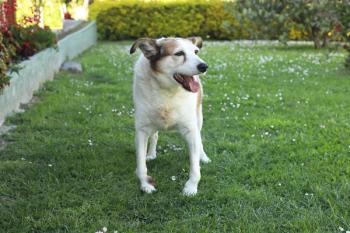
Cancer pain management (Proceedings)
Cancer pain management was not taught in veterinary schools until the 1990's.
Cancer pain management was not taught in veterinary schools until the 1990's. Interest in pain management for veterinary was introduced to our profession only after the 1985 Federal Animal Welfare Law, which officially recognized that pain and distress indeed occurs in laboratory animals (Rollin 2005). Dr. Charles Short and Dr. Alan Van Posnak edited Animal Pain, one of the first veterinary books that influenced how our profession addresses animal suffering. The ravages of cancer pain destroys the immediate quality of life for the pet and this hurts the morale of the pet's loving family.(Dawkins 2005) If cancer pain is not addressed properly, the bond that holds our profession together literally suffers a dead end. Cancer pain has the power to short circuit millions of human-animal bonds. Our profession's old knee jerk utilitarian answer to management of cancer pain has been, until recently, immediate euthanasia. When a painful cancer patient is prematurely extinguished, without the benefit of adequate pain control, we have not served our patient, our client or society to the best of our ability. (De Lorimier & Fan 2005)
The International Veterinary Association of Pain Management (IVAPM) is an excellent resource for education about pain management. Many technicians belong to this organization and take advantage of the list serve discussions on line. This "blog" is maintained by Tara, a committed pain management technician at CSU in Fort Collins. Contemporary pain management in cancer patients enables the cancer patient and their distraught family to have quality of life and peace of mind. Veterinarians and staff now have the tools to recognize and understand the complexity of chronic pain syndromes and its relation to cancer pain their animal patients. It is our ethical obligation to alleviate pain. (Gaynor & Muir 2008) This CVC Proceedings paper will help technicians get an overview on cancer pain management.
World Health Organization Analgesia Ladder
What You Can Do
Technicians, you can be the catalyst to alleviate untreated pain. Organize a special pain management staff meeting at your hospital. Agree to adopt pain management programs for specific procedures and conditions such as cancer. Agree to use the WHO pain management ladder for therapy and the CSU Pain Scoring System to assess patients and recognize pain.
Pain scoring system at Colorado State University
Pain's Pathways and Mechanisms
Pain uses many pathways and mechanisms to communicate and inflict the sensations of hurt to the body. It is beyond the scope of this paper to describe the multiplicity and complexity of the painful experience; however readers are advised to delve into the recommended references below, especially, the new 2nd edition of Handbook of Veterinary Pain Management by Gaynor and Muir.
With study, every technician can understand the biology of pain and the pharmacology available to properly alleviate the emotional and physiologic harm wrought upon pains pitiful victims. It is important to know that it often takes more than one class of pain medication and often a combination "pain cocktail" to effectively and adequately control cancer pain. Combination pain protocols can bring amazing relief. (Lascalles 2003)
Cancer Pain Control for Pawspice Pets
When cancer patients are diagnosed as terminal, the attending veterinarian and the pet owner often unwittingly allow the pet to live with untreated moderate to severe pain. Good client education would counsel and encourage pet owners to enter their pet into a palliative end of life, Pawspice, care program. The Pawspice program places pain control as a top priority. We generally offer the pet owner the option of using a Duragesic™ pain patch every 3 days. We shave both back legs of the patient and demonstrate the proper application and wrapping of the pain patches. The pet caregivers are asked to return the used fentanyl patch at recheck for proper disposal. Many pets will be places on combination drug protocols such as GAT, PAT, and MAT which will be discussed in greater detail below. If the family can't afford the pain patches or the combinations of pain medications, then we are obligated to offer the less costly options such as over the counter NSAIDs (with pepcid) and or nalbuphine. We should never allow the pet to hurt!
Multimodal Therapy for Cancer Pain
Never hesitate to enlist adjunctive help and acupuncture to fully control pain. Using amitriptyline (or other tricyclic antidepressants), gabapentin (or other anticonvulsants), bisphosphonates, and/or amantadine (or other N-methyl-D-aspartate (NMDA ) receptor antagonists) may enhance your ability to effectively alleviate cancer pain. Pain has the physiological effect of creating intense anxiety and stress. Using anxiolytic drugs along with NSAIDs and gabapentin (GAT) can be very helpful to ease the tension for overtly anxious patients. We rarely send butorphanol for management of chronic pain at home due to its short duration of analgesia and the fact that its sedation effect might fool the pet owner into thinking that there is no pain. Bupenorphine can be absorbed when placed in the cheek pouch of troublesome cats. It is not recommended for moderate to severe pain. The duration of analgesia generally lasts for 6-8 hours.
Long ago, this author adopted an integrative approach to cancer pain and arthritis pain. Acupuncture may help to alleviate cancer pain. In addition, other modalities of alternative and supportive care such as chiropractic, cold packs, hot packs, electrical stimulation, low level laser therapy (Shearer, 2005), massage therapy, prolotherapy, and magnetic therapy may compliment pain control efforts and further alleviate cancer pain. (Robinson 2005) If and when clients seek complimentary care to further alleviate their pet's pain, it may be in the patient's best interest for you to encourage the caregiver to give the modality a try. If the patient shows no pain relief and no benefit after four sessions of the alternative therapy, then that modality is obviously not effective and should be discontinued. Acupuncture and complementary medicine may also help alleviate the patient's anxiety and tension as well and create a sense of well being that offsets pain. The ambience established during most acupuncture sessions can also be very nurturing for the cancer patient and this in turn may comfort and empower the caregiver as well. We have repeatedly observed the anecdotal relaxation response of many anxious clients and anxious pet that are simultaneously given a solution known as Rescue Remedy™.
Using the combination of NSAIDs and opioids is very helpful for controlling moderate to severe cancer related pain and postoperative pain. (Conzemius1997) (Cambridge 2000) The fentanyl pain patch combines well with NSAIDs such as meloxicam for a postoperative nosectomy in a cat. Deracoxib or carprofen may be prescribed for a dog following amputation to supplement a fentanyl pain patch. The pain patch also combines well with oxymorphone and hydromorphone but not with butorphanol or nalbuphine. Local anesthesia and the placement of a lidocaine patch over incision sites is very comforting to reduce local and regional pain associated with mastectomy, amputation, thoracotomy, etc. (Gaynor & Muir 2008) Naloxone can be given to reverse the fentanyl pain patch's negative opioid side effects such as respiratory depression, bradycardia, dysphoria, noise sensitivity, hypothermia, vomiting, and diarrhea. The analgesic effect of the pain patch remains intact while the opioid reaction is reversed.
Meloxicam is one of the few approved NSAID's that is safe to use for cats, although carprofen, ketoprofen and aspirin are commonly used. Meloxicam is ideal in combination with the fentanyl patch to alleviate chronic oral cancer pain for cats. It is approved for a one-time injection in cats. It is ideal to administer as the patient is recovering from anesthesia as a supplement to the freshly placed pain patch. It provides immediate pain relief for cancer patients undergoing painful surgical cases such as mandibulectomy or thoracotomy. The meloxicam injection wears off over 24 hours while the fentanyl patch takes effect. This combination provides even, sustained pain control for feline patients that have normal hydration and renal function. Meloxicam with Amantadine and Tramadol serves as the "MAT" which can be a useful cancer pain combo.
Meloxicam liquid can be used postoperatively for two weeks to control pain in cats on a tapering oral dose starting with 0.2 mg/kg on day 1. Half of this dose (0.1 mg/ kg) is given on the following 4 days and then it is halved again to 0.05 mg/kg for 10 days. For further use, the dose is halved again to 0.025 mg/kg once daily.
The long-term use of NSAIDs in cats has not been specifically studied for hazards and drug interactions. However, experience with the use of 1mg of piroxicam every other day for feline oral SCC cases has given this author and others confidence. The extralable and judicious usage of NSAID's can benefit the quality of life and the survival of geriatric feline oncology patients if the patient's hydration and renal function is maintained within normal limits.
Various NSAIDs compliment the fentanyl patch and are routinely given to older dogs for severe postoperative pain and for chronic cancer pain control. Tramadol may also be co administered with NSAIDs for improved control of cancer pain. Precautions should be taken to monitor for ulcers and adjust the dose for pets with liver and kidney disease when using any and all NSAID's.
The fentanyl pain patch or oral tramadol can be combined with steroids to achieve excellent pain control for moderate to severe pain in both cats and dogs. Amitriptyline or clomipramine may be helpful in reducing anxiety, stress and pain when used in combination with NSAIDs, opioids or steroids. Tricyclic antidepressants would be a good option for patients with brain tumors that exhibit circling, head tilt, tremors, or facial paralysis. Treat all pets with brain tumors preemptively for headache pain. Ask yourself the question, "If I had this cancer, would I be in pain?"
Nalbuphine as an Option
Nalbuphine injectable solution has become one of this author's favorite and most versatile pain medications. Since it is inexpensive, it is a great option for pet owners who are on a slim budget, especially if their pet is a large or giant breed dog. The duration of pain relief provided ranges from 1-6 hours. Therefore it is important for the pet owner to be able to assess pain in pet and administer the subcutaneous injections every 3-6 hours preemptively. Nalbuphine injectable solution can also be given orally or put in the food if the pet owner is uncomfortable giving injections.
Nalbuphine is a narcotic agonist-and partial antagonist, which provides pain relief for moderate to severe and resistant cancer pain. It calms the patient without causing heavy sedation, respiratory depression and bradycardia associated with of opioids. The generic preparation is a colorless, tasteless solution, which is convenient to use for home care. The cost is affordable, especially when contrasted with other well known pain medications for large dogs. Be sure to specify that you want the generic injectable nalbuphine and not Nubain™ when you order it; otherwise you will pay for the costly trade name.
We often favor the use of nalbuphine as our first option for cancer patients, especially cats, that fight oral medications, or for patients that are intolerant of pain patches and NSAIDs. We also use nalbuphine in combination with NSAIDs for pets that have chronic or resistant cancer pain. It is a great option for treating cats with oral tumor pain, from lingual, mandibular and maxillary squamous cell carcinoma, etc. The dose ranges from 0.2-0.5 mg/kg given S.Q. as needed two or three times daily for dogs and 0.1-0.3mg/kg three to four times daily for cats. Nalbuphine may be sent home for P.O. or S.Q. use without the typical narcotics precautions. Nalbuphine has less sedation effects than other similar analgesic compounds. (Villalobos 2000) We dilute it one part to 9 parts with sterile saline or water and dispense it in vials for cats and small dogs. Generally a cat or 10-15 pound dog would do well with 0.1 ml of the diluted solution every 3-6 hours as needed for intense cancer pain.
Compounding Pharmacies
Compounding pharmacies prepare pain control medications so that a measurable aliquot can be identified and given for small dogs and cats. They prepare palatable formulations that are easy and safe for the pet owner to use. When engaging a compounding pharmacist or writing a prescription, it is best to clearly state the desired dose and frequency of medication that the patient is to receive. For instance, the piroxicam dose commonly used for bladder cancer in dogs (Knapp et al,1997) (Boria et al, 2005) and for squamous cell carcinoma (SCC) in cats is generally at 0.3m/kg. It is standard to use one10mg piroxicam capsule for a 60-pound dog every 24-48 hours. It is standard to use 1 mg per cat every 48 hours. Be very careful when writing out or calling in orders to a compounding pharmacy for cats being prescribed piroxicam. I would say or write: piroxicam, sig: 1 mg PO every 48 hours or l mg every other day. This dose would be one tenth of a 10 mg capsule or tablet. Make sure that the client is warned about the toxicity of overdosing. The non offensive taste and clearly marked dosing syringe packaged with liquid meloxicam makes it a very convenient NSAID for pet owners to use.
Sam's Case: Lesson Learned: Don't Fail to Provide Enough Analgesia
Sam, an M/N, 11 year-old Labrador Retriever developed a large hemangiosarcoma originating in his left quadriceps muscle. His family told me that Sam cried and whimpered for hours after being sent home following his hind leg amputation. His surgeon was unavailable at night, so they took Sam to an emergency room at 2:00 AM for a pain injection. But Sam only got an hour or two of relief from that injection and started crying again at 4:00 AM. The clients were frustrated with both the attending surgeon and the emergency room doctor for not giving Sam more potent and longer acting pain management. Do not fail to provide your surgical oncology patients multimodality pain control to avoid Sam's scenario.
Summary
When adequate analgesia is not given at the start of a painful event (preemptively), it may lead to chronic, unrelenting pain. Since animals are stoic and often misinterpreted at the onset of their pain, we can presume that there is a lot of chronic pain in older animals and especially cancer patients. Since one in four animals over the age of two, and half of the pets over the age of ten, will die of cancer, we must anticipate and manage their cancer pain. It is sad that our profession and the companion animal community have previously allowed so much cancer pain to go untreated. Veterinarians and veterinary technicians have the obligation to create a more comfortable quality of life for their cancer patients as they live with cancer in palliative programs such as Pawspice. When cancer pain is unresponsive to informed, multimodality treatment efforts, then we can feel more justified in helping our cancer patients to find peace by way of the gift of euthanasia. (Tranquilli 2004 ) If your clients feel satisfied with their pet's quality of life and your compassion and expertise in cancer pain management, then you have served them well in the battle against the ravages of cancer.
References
Boria, P.A., Glickman. N.W., Schmit, B.R., et al., Carboplatin and Piroxicam Therapy in 31 Dogs with Transitional Cell Carcinoma or the Urinary Bladder, Veterinary and Comparative Oncology, Vol. 3, no. 2, June 2005, p 73-80.
Cambridge, A.J., Tobias, K.M., Newberry, R.C., Sarkar, D.K.: Subjective and Objective Measurements of Postoperative Pain in Cats, JAVMA, Vol.217. No. 5, September 1, 2000, Scientific Reports Original Study, p 685-690.
Conzemius, M.G., Hill, C.M., Sammarco, J.L., Perkowski, S.Z., Correlation Between Subjective and Objective Measures used to Determine Severity of Postoperative Pain in Dog, JAVMA, Vol. 210. No. 11, June 1, 1997, Original Study, p 1619-1622.
Dawkins, M. S., The Science of Suffering, Ch 4, Mental Health and Well-Being in Animals, ed., McMillan, F. D., Blackwell Publishing, 2005, p 47-55.
De Lorimier, L.P., Fan, T.M., Understanding and Recognizing Cancer Pain in Dogs and Cats, Treating Cancer Pain in Dogs and Cats, Veterinary Medicine, May 2005, p352- 377.
Gaynor, J.S., Muir, W.W., Handbook of Veterinary Pain Management, Mosby/Elsevier, 2008.
Hellyer, P.W., Gaynor, J.S.: Acute Postsurgical Pain in Dogs and Cats, The Compendium, Vol. 20. No. 2, February 1998, p. 140-153.
Knapp, D.W., Richardson, R.C., Chan, T.C., et al, Piroxicam Therapy in 34 Dogs with Transitional Cell Carcinoma of the Urinary Bladder, JVIM, 8:723. 1994.
Lascalles, B.D.X., Relief of Chronic Cancer Pain, Chapter 13, BSAVA Manual of Canine and Feline Oncology, 2nd Ed., 2003, p137-151.
McMillan, F.D., Emotional Maltreatment in Animals, Ch 12, Mental Health and Well-Being in Animals, Ed., McMillan, F. D., Blackwell Publishing, 2005, p 167-179.
Morrison, W.B., Cancer in Dogs and Cats, Medical and Surgical Management, Teton New Media, 2002.
Muir, W., et al: Pain and Pain Therapy, Seminar to VCA Staff Doctors 2001.
Pain Management in Companion Animals, A Roundtable on Butorphanol Tartrate, A Supplement to Veterinary Forum, Volume 20 (5A), 2003.
Rollin, B.E., On Understanding Animal Mentation, Ch 1, Mental Health and Well-Being in Animals, ed., McMillan, F. D., Blackwell Publishing, 2005, p 3-14.
Robinson, N., Complimentary Medicine, Prolotherapy for Pain Entering Mainstream, Veterinary Practice News, 2005.
Shearer, T.S., High-Tech Pain Management for Pets, Low-Level Laser Therapy User's Manual for Veterinarians, Ohio Distinctive Publishing, 2004.
Stein, C. et al: The Control of Pain in Peripheral Tissue by Opioids, Mechanisms of Disease Vol. 332 No. 25 p 1685-1690.
Smith, L.J., Practical Analgesia in Cats, Veterinary Medicine, August 2005, p.602-609.
Tranquilli, Grimm, Lamont, Pain Management for the Small Animal Practitioner, 2nd Edition, Teton New Media, 2004.
Villalobos, A.E., Conceptualized End of Life Care: Pawspice Program for Terminal Pets, AVMA 2000, Salt Lake City, Convention Notes, July 2000, p 322-327.
Newsletter
From exam room tips to practice management insights, get trusted veterinary news delivered straight to your inbox—subscribe to dvm360.






